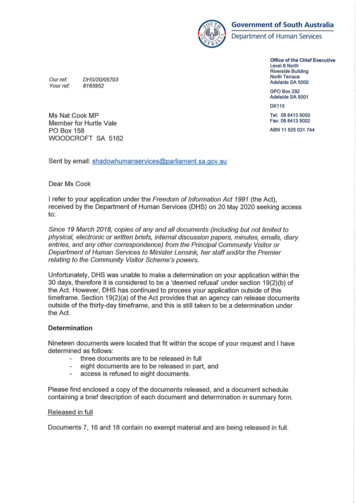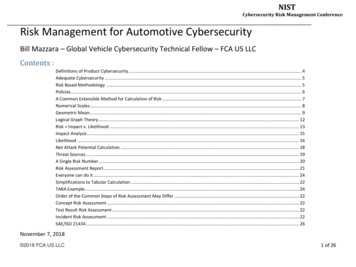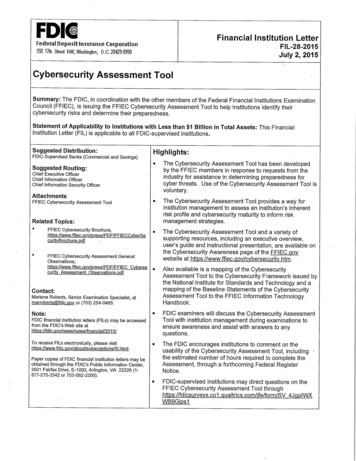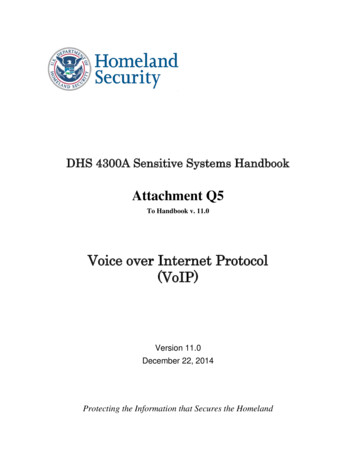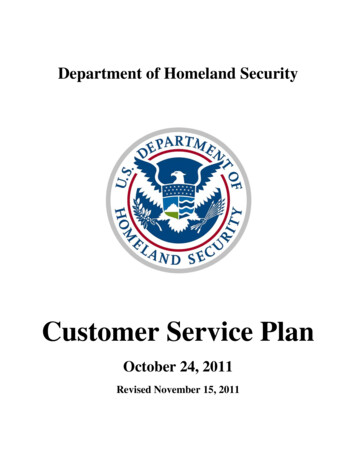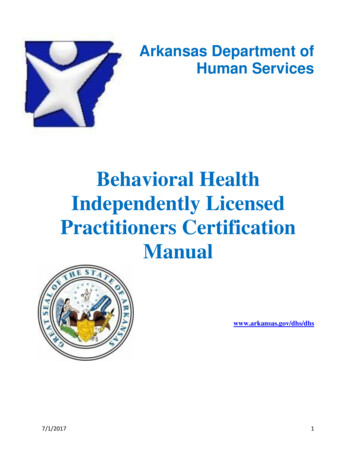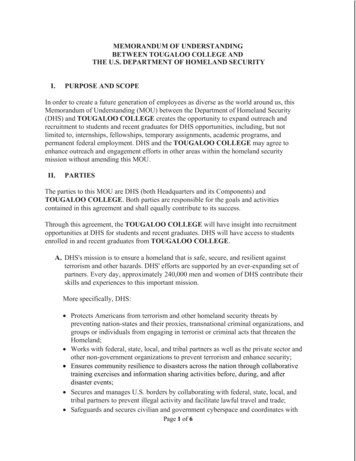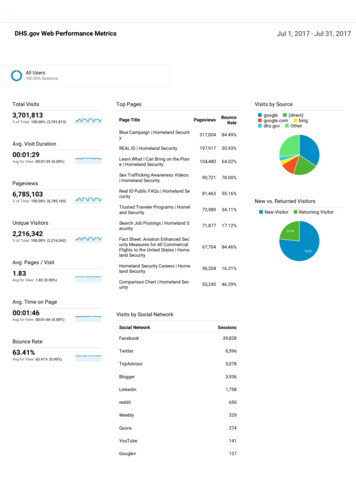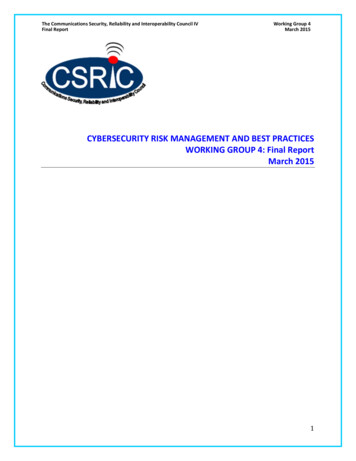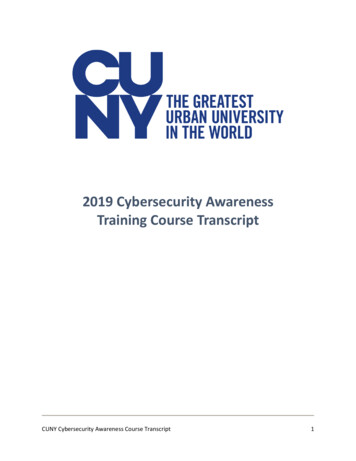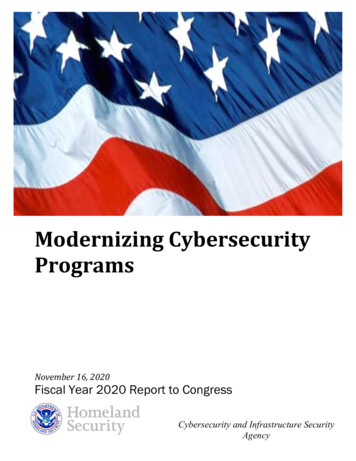
Transcription
Modernizing CybersecurityProgramsNovember 16, 2020Fiscal Year 2020 Report to CongressCybersecurity and Infrastructure SecurityAgency
Message from the DirectorNovember 16, 2020I am pleased to provide the following report, “ModernizingCybersecurity Programs,” which has been prepared by theCybersecurity and Infrastructure Security Agency (CISA).This report was compiled pursuant to direction in the JointExplanatory Statement, House Report 116-180, and SenateReport 116-125, all accompanying the Fiscal Year (FY) 2020Department of Homeland Security (DHS) Appropriations Act(P.L. 116-93).Pursuant to congressional requirements, this report is beingprovided to the following Members of Congress:The Honorable Lucille Roybal-AllardChairwoman, House Appropriations Subcommittee on Homeland SecurityThe Honorable Chuck FleischmannRanking Member, House Appropriations Subcommittee on Homeland SecurityThe Honorable Shelley Moore CapitoChairman, Senate Appropriations Subcommittee on Homeland SecurityThe Honorable Jon TesterRanking Member, Senate Appropriations Subcommittee on Homeland SecurityInquiries relating to this report may be directed to CISA Legislative Affairs at (202) 819-2612.Sincerely,Christopher C. KrebsDirectorCybersecurity and Infrastructure Security Agencyi
Executive SummaryCISA is leading the civilian governmentwide effort to improve cybersecurity operations,including agencies’ visibility into their networks (in both cloud and on-premises environments)to detect and respond to cybersecurity incidents effectively.CISA is applying experiences gained from initial research and pilot efforts to improve itsNational Cybersecurity Protection System (NCPS) and Continuous Diagnostics and Mitigation(CDM) capabilities. CISA is working closely with the Federal Risk and AuthorizationManagement Program and other entities within the U.S. General Services Administration toensure that when contracting with cloud providers, agencies can use governmentwide securityclauses to ensure better data protections. To this end, CISA is identifying new capabilities andstrategies to protect government data in the cloud by both cloud tenants (agencies) and the cloudservice providers (CSP) or by cloud security access brokers (CSAB) that serve as sources foragencies’ hardware, software, infrastructure, and security services.NCPS is an integrated system-of-systems that provides intrusion detection and preventioncapabilities, advanced analytics, and information-sharing mechanisms that mitigate cyber threatsto federal civilian networks and augment their internal cyber capabilities. The NCPS suite ofcapabilities enables CISA to enhance the security of federal agencies against advanced cyberthreats. NCPS capabilities are evolving to support the increasing adoption of cloud services.Although traditional network intrusion detection and prevention capabilities remain useful,NCPS must evolve. The NCPS program is working with agencies and their CSPs and CSABs toidentify and pilot solutions for their evolving architecture. The combination of CDM and NCPScapabilities in the cloud are expected to provide agencies as well as CISA with the capabilitiesand data necessary to meet this mission.Over the last several years, CDM has expanded its core cybersecurity capability offeringsthrough the Dynamic and Evolving Federal Enterprise Network Defense acquisition program toprovide greater flexibility to agencies for implementing the CDM requirements. The CDMprogram has defined how its capabilities can be deployed to the cloud including completion of apilot with the Small Business Administration, which has moved a significant portion of its dataprocessing to the cloud.CISA is committed to consistent and continuous improvement of security operations at federalcivilian agencies and is adapting the current capabilities of CDM and NCPS while also planningfor long-term capability enhancements. CISA also is working with the Office of Managementand Budget to evaluate the current state of cybersecurity operations across the FederalGovernment and to identify and standardize the core security operations centers (SOC)capabilities offerings in the agencies. Based on their specific needs and availability of internalcapacity and expertise, agencies eventually will be able to decide whether to supplement theirexisting capabilities with individual, third-party-provided SOC services, or to migrate their SOCoperations to a SOC-as-a-Service model.ii
Modernizing Cybersecurity ProgramsTable of ContentsI.Legislative Language .1II.Background .2III.Discussion .4A. Continuous Diagnostics and Mitigation Program .Keeping CDM Operationally Effective .Continuing pilot programs that extend incident detection and prevention to federalendpoints .A long-term, strategic vision .44B. National Cybersecurity Protection System Program .NCPS Modernization .Modernizing the EINSTEIN Sensor Suite .How Agency Cloud Adoption Affects NCPS.NCPS Cloud Telemetry Cycle .Benefits of Sharing Cloud Security Data With CISA.NCPS Roles, Responsibilities, and Cloud Operations .CISA Cloud Data Aggregation .Cloud Log Aggregation Warehouse Overview .CLAW Distribution .CISA Analysis of Agency Data .Modernizing the NCPS Core Infrastructure and Capabilities .NCPS Infrastructure Modernization .NCPS Application Environment.6888910101212121314141455IV. Conclusion . 16Appendix - Abbreviations . 17iii
I.Legislative LanguageThis document was compiled pursuant to language set forth in the Joint Explanatory Statement,House Report 116-180, and Senate Report 116-125, all accompanying the Fiscal Year (FY) 2020Department of Homeland Security (DHS) Appropriations Act (P.L. 116-93).The Joint Explanatory Statement states:CISA is directed to provide a report not later than 180 days after the date ofenactment of this Act detailing how CISA will modernize CDM and NationalCybersecurity Protection System (NCPS), including EINSTEIN, to ensure theyremain operationally effective given changing trends in technology, the federalworkforce, threats, and vulnerabilities. The report shall address the requirementsdescribed in the House and Senate Reports.House Report 116-180 states:The Committee is concerned with the security implications of an increasinglymodern federal workforce, which includes more remote employees, enhancedmobility, and an increased focus on cloud technologies. CISA is directed to briefthe Committee not later than 180 days after the date of enactment of this Act on adetailed plan to modernize CDM and NCPS to ensure they remain operationallyeffective given changing trends in technology, the federal workforce, threats, andvulnerabilities. The briefing shall include: (1) a long-term, strategic vision for theprogram to ensure that CDM and NCPS capabilities continue to develop and evolvein an agile manner to address contemporary technology use and vulnerabilities andcombat emerging cybersecurity threats; (2) an assessment of whether emergingprivate sector technologies that focus on securing endpoints could integrate withexisting program capabilities to enhance the overall effectiveness of CDM andNCPS; and (3) preliminary results from all CDM and NCPS-related pilot programs.Senate Report 116-125 states:CISA is directed to provide a report no later than 180 days after the date ofenactment of this act detailing how CISA will modernize the NCPS, includingEINSTEIN. The report should include how EINSTEIN will remain relevant givenchanging trends in technology and the Federal workforce and provide a strategicoutlook for how CISA plans to evolve EINSTEIN over the next 5 years. The reportshould address emerging technologies, including those which focus on securingendpoints, and how emerging technologies could be integrated with existingprogram capabilities to enhance EINSTEIN’s overall effectiveness.1
II. BackgroundThe Cybersecurity and Infrastructure Security Agency (CISA) is leading the civiliangovernmentwide effort to improve federal cybersecurity operations, including agencies’ visibilityinto their networks (in both cloud and on-site environments) to detect and respond tocybersecurity incidents effectively. CISA is ensuring that its cyber programs remainoperationally effective given the changing trends in technology, the federal workforce, threats,and vulnerabilities. Further, experience with increased telework since March 2020 has causedCISA’s major cybersecurity programs (NCPS and Continuous Diagnostics and Mitigation[CDM]) to focus their efforts further on information technology (IT) modernization, includingthe interim telework guidance released in April. 1NCPS is an integrated system-of-systems that provides intrusion detection and preventioncapabilities, advanced analytics, and information-sharing mechanisms that mitigate cyber threatsto federal civilian networks. These capabilities provide a technological foundation that enablesCISA to secure federal agencies against advanced cyber threats.NCPS capabilities are evolving to support the increasing adoption of cloud services. The legacyintrusion detection capabilities were designed to support a perimeter-based network architecture.Although traditional network intrusion detection and prevention capabilities remain useful,NCPS must evolve its capabilities, such as being able to ingest cloud security data fromcommercial cloud vendors. The NCPS program is working with agencies and cloud serviceproviders (CSP) to identify and pilot solutions that support the evolving architecture. Thecombination of CDM and NCPS capabilities in the cloud are expected to provide agencies aswell as CISA with the capabilities and data necessary to meet this mission.The CDM program bolsters agency cyber defenses and enhances the security posture of theFederal Government by providing federal agencies with capabilities to monitor risks to theirnetworks in near real-time. This increased situational awareness allows agencies to prioritizeactions to mitigate or accept cybersecurity risks based on an understanding of the potentialimpacts to their mission. The CDM program accomplishes this by deploying commercial offthe-shelf tools on agency networks that provide enterprisewide visibility of what assets, users,and activities are on their networks. This actionable information allows agencies to monitor,defend, and respond rapidly to cyber incidents. CDM capabilities are organized into five keyprogram areas: deployment of agency and federal dashboards, asset management, identity andaccess management, network security management, and data protection management.CISA’s cybersecurity programs directly support the following federal goals and mandates: Report to the President on Federal Information Technology (IT) Modernization asprovided under Executive Order 13800 (May 11, 2017);See CISA, Trusted Internet Connections 3.0, Interim Telework Guidance (April 8, 2020), available uidance2020.04.08.pdf.12
President’s Management Agenda, which includes an IT priority of reducing cybersecurityrisks to the federal mission by leveraging current commercial capabilities and byimplementing cutting-edge cybersecurity capabilities; Federal Information Security Modernization Act of 2014, which authorizes DHS todeploy technology to assist agencies in continuously diagnosing and mitigating cyberthreats and vulnerabilities; Office of Management and Budget (OMB) Circular No. A-130 (2016 revision),Managing Information as a Strategic Resource, which directs federal civilian agencies todevelop and implement information security continuous monitoring strategies; and OMB Memorandum M-20-04, Fiscal Year 2019-2020 Guidance on Federal InformationSecurity and Privacy Management Requirements, which provides guidance to agencieson strengthening CDM capabilities.To ensure that both programs continue to evolve with a rapidly changing cyber environment,CISA is committed to continuous program improvements. CISA has established the .gov CyberArchitecture Review (.govCAR) methodology to conduct threat-based assessment of cybercapabilities. This approach looks at the target architecture the way that an adversary does anddirectly identifies where mitigations can be applied for the best defense against all phases of acyber-attack. The .govCAR methodology parallels the Department of Defense’s project knownas the Department of Defense Cybersecurity Analysis and Review, which introduced the conceptof a threat-based, end-to-end analysis of large, enterprise cybersecurity architectures. It is usedto provide direction and justification for CISA’s cybersecurity programs in that any .govCARrecommendations regarding the efficacy of certain technologies is considered during investmentreview.This report provides insight into how CISA is ensuring that its cyber programs remainoperationally effective given the changing trends in technology, the federal workforce, threats,and vulnerabilities.3
III. DiscussionA. Continuous Diagnostics and Mitigation ProgramKeeping CDM Operationally EffectiveCISA is focused on ensuring that CDM capabilities remain operationally effective. From thecontracts perspective, CDM is using its Dynamic and Evolving Federal Enterprise NetworkDefense (DEFEND) contract vehicle, offered under the U.S. General Services Administration’sAlliant/Alliant II offering, which includes various improvements over CDM’s initial contractvehicles. The DEFEND contracts offer higher ceilings, longer periods of performance, and allCDM capabilities offering much more flexibility to agencies to match their requirements.Further, in May 2020, CDM awarded its next-generation shared services platform to ensure thatthe smaller, non-Chief Financial Officers Act of 1990 (P.L. 101–576) (CFO Act) agencies canleverage CDM capabilities in a cost-efficient manner, enabling them to manage their assets,identities and accounts, and network services, and to protect their data on par with the CDMtools and resources available to the much larger CFO Act agencies. Today, 36 non-CFO Actagencies are operational on the existing shared services platform.Recognizing that the federal workforce is highly mobile, CDM is adding mobile assetmanagement capabilities in the next year. CDM will interface with agencies’ enterprise mobilitymanagement systems to align mobile asset reporting better. CDM also plans on providingmobile threat capabilities to reinforce the security of agencies’ enterprise mobility managementsystems and mobile devices.Through CDM, CISA also is providing data protection management capabilities to agencies,which offer strong protection to the sensitive data on some of the Federal Government’s mostcritical systems, termed high-value assets (HVA). HVAs include networks that are essential tothe agency functions, are designated as essential to maintaining the security and resiliency of thefederal civilian .gov enterprise, or both. With the data protection management capability, CISAis working with agencies and industry to strengthen the data protections of the FederalGovernment’s HVAs. These tools provide the HVAs with advanced threat-detectioncapabilities.CDM also is transitioning the agency and federal dashboard ecosystem in 2020, offering higherperformance, more flexibility, and greater scalability. The migration to a robust big dataplatform will evolve into significant advances over time, as the CDM program adds capabilitiesand functionality to promote situational awareness for threat-based defense. These capabilitieswill include enhanced vulnerability prioritization, threat-based data enrichment, incidentresponse reporting and orchestrated workflow, integration with additional NCPS capabilities,data analytics, and machine learning. The new dashboard will ingest data into a commonschema, which will make analytics sharing across agencies or their bureaus much easier.4
In addition, CISA will be evaluating the efficacy of incorporating “break and inspect”capabilities into the CDM architecture to address challenges associated with inspecting andsecuring encrypted network traffic at scale without degrading performance. The CDM programis working with NCPS and trusted internet connection (TIC) programs to evaluate “break andinspect” opportunities against the risks of decrypting sensitive government data. Concernsregarding the potential increase in attack surface that this methodology might introduce to bothagencies and DHS must be addressed and mitigated.Continuing pilot programs that extend incident detection and prevention to federalendpointsTo extend CISA’s incident detection and prevention capabilities to federal endpoints, CISA’sCDM program and Threat Hunting subdivision have been working since 2019 to pilot newefforts. CISA is working with the respective agencies to identify appropriate endpoints, existingtools, and other details for pilots that began in the fourth quarter of FY 2020.The pilots will use existing host-based sensors to provide real-time cyber information to agencyand CISA cyber analysts. The pilots will allow the teams to consider the value of the sensor datareceived and to gain early experience on whether such an approach merits more widespreadconsideration across the federal network enterprise.A long-term, strategic visionCISA’s long-term strategy has been informed by the significant sudden growth in teleworking bythe Federal Government over the last few months. While the agency was keenly aware alreadyof the need for agility and flexibility for its cyber programs, that need was reinforced fully inmid-March when the entire Federal Government shifted to telework environments. In response,CISA continued to support its federal (and other stakeholders) albeit with a new emphasis onremote meetings, video calls, multi-platform collaboration tools, etc. CISA is leveraging thisdigital transformation and sharpening its focus on new work modes, new tools, future products,and evolving workforce efficiencies.Additionally, CISA has responded by surging additional CDM resources to agencies urgentlyrequiring support for accelerated moves to the cloud, strengthening asset and identitymanagement, and other activities.The ongoing federal transition from on-premises architectures to cloud-computing modes createsa fundamental shift for agency cybersecurity. Because of the complex and disparate nature ofcloud computing, this transition affects the location, means, and methods of protecting agencydata. When agencies adopt a data-centric security approach, in which data itself isconceptualized as an asset, it necessitates an evolution in the ways by which agencies protectdata regardless of its location. CISA’s CDM capabilities are adapting to align with this newdesign approach.5
Ensuring that CDM’s capabilities and outcomes are achieved fully relies in part on expandedpilots and sharing industry best practices and lessons learned with the agencies. Following areexamples of cloud initiatives that CDM has completed or has underway.CDM Cloud Guidance Document: Version 2 of the CDM Cloud Guidance Document will bereleased in the fourth quarter of 2020. It will focus on threats to cloud ecosystems and, wherepossible, will identify the data flows and sources available today that will help agencies to gainvisibility into their risks. This will include, for example, a focus on Identity, Credential, andAccess Management, which will allow agencies to focus resources on strengthening cloud accessto data assets. The document will outline fundamental principles, challenges, and recommendedpractices for protecting identity assets and infrastructure in cloud environments.Version 2 also will incorporate the threat-based .govCAR methodology, which assessesvulnerabilities in an architecture the way that an adversary may, and then directly identifieswhere mitigations can be applied for the best defense against all phases of a cyberattack.CDM DEFEND Cloud Activities: Experience and best practices gained from initial release ofthe cloud discovery activities under the DEFEND-C Task Order will be used to refine futurecloud activities at other federal agencies.CDM Cloud Pilot Project: As noted earlier, CDM partnered with the Small BusinessAdministration to conduct a pilot on using cloud-native tools to support CDM requirements. Thepilot report, released in May 2020, identifies successes and pinpoints potential capability gapsrelated to functional and operational requirements and dashboard capabilities. The report willinform the future direction of CDM with respect to cloud efforts.CDM Cloud Lab: CDM is taking a threat-based approach to achieve visibility in the cloudecosystems. Cloud architectures present various challenges to CDM’s collection of actionableand relevant information such as what data helps agencies to understand their cloud securityrisks, how to organize this information into meaningful groupings that then can be analyzed andrisk scored, and to identify who is accessing these cloud architectures and what they are doingonce they have been granted access. This approach identifies CDM capabilities that will beprioritized under cloud activities and the common data sources that might exist in various cloudtechnology platforms.B. National Cybersecurity Protection System ProgramNCPS is an integrated system-of-systems that provides intrusion detection and preventioncapabilities, advanced analytics, and information-sharing capabilities that together provide toboth CISA and federal agencies the ability to mitigate cyber threats. The NCPS capabilities, andspecifically the EINSTEIN intrusion detection and prevention sensor suite (EINSTEIN 1[E1]/EINSTEIN 2[E2]/EINSTEIN 3 Accelerated [E3A]), are capabilities that support a defense-indepth approach in support of CISA’s federal network defense mission. Intrusion Detection: NCPS’s intrusion detection capabilities such as E1 (Netflow) andE2 (Intrusion Detection) alert CISA and federal agencies to malicious activity within6
their networks. Using a signature-based sensor grid, the system monitors network trafficfor malicious activity traveling to and from federal networks. Signatures are specificpatterns of network traffic that can be used to identify malicious activity and are derivedfrom numerous sources, such as commercial cyber threat information, incidents reportedto CISA, information from CISA’s partners, or in-depth analysis. Intrusion detectionprovides federal agencies with near real-time detection and notification capabilities. In2018, NCPS operationalized a nonsignature-based detection system that enhances CISA’sintrusion detection capabilities to include functionality that detects deviations fromnormal network behavior baselines. Intrusion Prevention: NCPS’s intrusion prevention capabilities are delivered throughthe E3A portion of the program and are capable of automatically detecting andresponding to cyber threats in near real-time. Deployed directly by the internet serviceproviders (ISP) that provide service to the Federal Government, the system leveragesclassified and unclassified indicators to block known malicious traffic before it reachesagency networks. This allows for enhanced cybersecurity analysis, situational awareness,and security response, providing for active network defense and the ability to limitmalicious activities from penetrating federal networks. Analytics: CISA cyber analysts compile and analyze information about current andpotential cybersecurity threats. This information is shared, consistent with statutorylimits on how NCPS information can be retained, used, and disclosed 2, with CISA’spublic- and private-sector partners and the public. NCPS’s analytics capabilities includea range of technologies, including Security and Event Management, Packet Capture,Enhanced Analytical Database and Flow Visualization, and Advanced Malware Analysis. Information Sharing: CISA shares much of this analysis, along with additionalcomputer network security information, with its public- and private-sector partnersrapidly and in a secure environment. NCPS-derived analysis also is shared throughcommercial data feeds, internally generated analytic products, analytics tools, threatindicators and warnings, and real-time incident and continuous monitoring data. Theseservices provide CISA cyber analysts and their cyber partners with a common operatingpicture of the threat landscape. All information sharing is accomplished consistent withstatutory limits on how NCPS information can be retained, used, and disclosed. Core Infrastructure: NCPS Core Infrastructure capabilities comprise the backend datastorage and processing environment, known as the Mission Operational Environment,including network devices, storage devices, database services, application hostingservices, and security controls. These capabilities relate to the command and control ofthe EINSTEIN sensors and services. This capability also includes the Analytics andInformation Sharing environment for CISA operators and analysts.2See 6 U.S.C. § 663(c)(3).7
NCPS ModernizationThe NCPS program is evolving to ensure that security information from federal agencies’ cloudbased traffic can be captured and analyzed for CISA cyber analysts to provide situationalawareness and support to the agencies. This is occurring primarily through the modernization ofNCPS EINSTEIN capabilities. In addition to developing the EINSTEIN cloud-basedarchitecture to collect and analyze agency cloud security data, NCPS also is modernizing itsbackend analytic, information- sharing, and core infrastructure areas to improve CISA’s abilityto collect, process, analyze, and share cyber data with its stakeholders through Federal Risk andAuthorization Management Program-authorized commercial and government cloud services.This NCPS modernization effort will reduce capital infrastructure investments at DHS datacenters and will allow the NCPS program to be more agile in meeting evolving cyber threats andmission needs. Lastly, the increased utilization of commercial cloud capabilities across NCPSwill improve the scalability, availability, and reliability of the infrastructure, capabilities, andservices for CISA and federal agencies.Modernizing the EINSTEIN Sensor SuiteAs agencies move more of their applications and services to the cloud, the NCPS program isevolving to ensure that security information about cloud-based traffic can be captured andanalyzed and that CISA cyber analysts can continue to provide situational awareness and supportto the agencies. Traditionally, TIC access points (either MTIPS gateways or agency-managedTIC access points 3) contain EINSTEIN 4 sensors, so when an agency participates in the TICprogram, it also automatically utilizes the capabilities of the NCPS program. As such, agenciestraditionally have been able to fulfill NCPS requirements simply by complying with the TICprogram. However, in 2019, OMB issued an updated TIC policy, OMB MemorandumM-19-26 5, which does not require TIC access points to be embedded in all TIC use cases. Manyof these new TIC use cases describe cloud services. In these use cases, network traffic betweenan agency and a CSP does not pass through an EINSTEIN sensor.As agencies and CISA adopt cloud environments and conform to the new TIC use cases, theywill continue to share telemetry and security insights.How Agency Cloud Adoption Affects NCPSAs part of their IT modernization efforts, many agencies are utilizing commercial cloud productsand adopting cloud email, collaboration, and software tools. Many agencies are using multipleCSPs in order to meet their mission needs and are utilizing all three cloud service models:Software as a Service (SaaS), Platform as a Service, and Infrastructure as a Service. 6 When anagency creates a tenancy within a CSP, traffic between that CSP and the agency no longer maypass through a TIC access point or an NCPS f6Email as a Service is a
CISA is leading the civilian governmentwide effort to improve cybersecurity operations, including agencies' visibility into their networks (in both cloud and on-premises environments) to detect and respond to cybersecurity incidents effectively. CISA is applying experiences gained from initial research and pilot efforts to improve its
